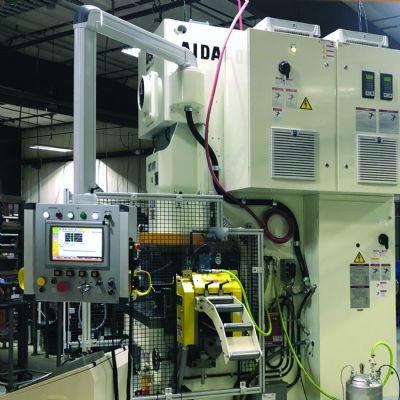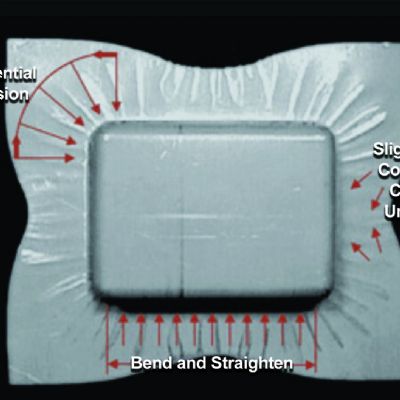During some types of forming, the ram comes to a complete stop when the tool closes fully on the part. Because standard piston pumps have a reaction time of about 120 msec., they will continue to generate flow after the press ram stops. That can cause hydraulic-pressure spikes and damage to the entire system over time.
Some damage is more acute, such as pipe breakage. Pipes welded to the reservoirs have, in some cases, broken off as a result of the excess pressure, exposing the system to air and contamination. Pressure-compensated piston pumps with electronic pump control are engineered to prevent that damage. The press control can preemptively track that stoppage and direct the pump to reduce the flow at a strategic point. The control knows in advance that the press is about to stop, so it can reduce the flow to reduce or prevent the spike. This keeps the pressures within acceptable parameters and makes it much easier on the system.
Electronically controlled piston pumps equipped with an energy-efficient, variable-frequency drive can reduce the rotations/min. and the pumps’ flow and hold a tonnage for a long period while reducing energy consumption by as much as 90%. They’re useful in any operation featuring a lengthy dwell time, such as deep drawing, but prove most useful for hydroforming, superplastic forming of titanium and compression molding.
Integration of Servo Technology in Hydraulics
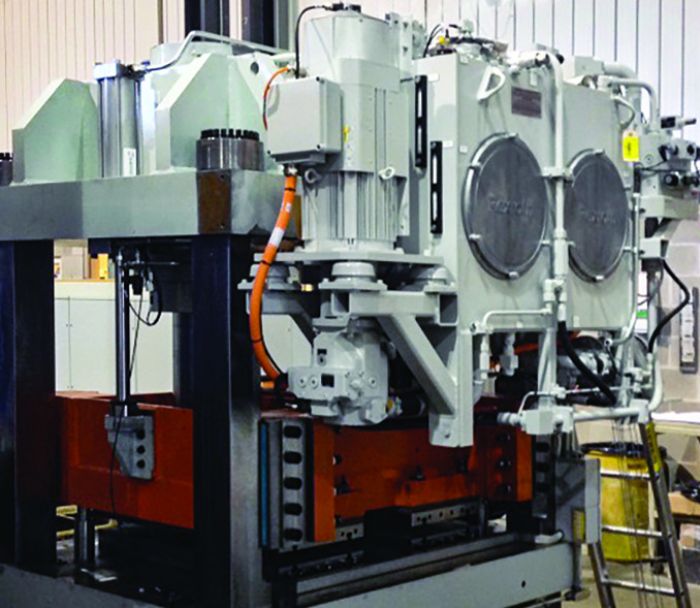 A misperception exists that a “servo press” is a completely different type of press, but what many people call a “servo press” actually is a servo-driven mechanical press: a mechanical-geared link press in which the flywheel has been replaced with a servo drive. Alternatively, servohydraulic presses integrate servo control directly into the hydraulic system, allowing for variable flow and precise force control. Servo technology has emerged in the hydraulic press arena as a means of reducing energy consumption, exerting greater control and enhancing flexibility.
A misperception exists that a “servo press” is a completely different type of press, but what many people call a “servo press” actually is a servo-driven mechanical press: a mechanical-geared link press in which the flywheel has been replaced with a servo drive. Alternatively, servohydraulic presses integrate servo control directly into the hydraulic system, allowing for variable flow and precise force control. Servo technology has emerged in the hydraulic press arena as a means of reducing energy consumption, exerting greater control and enhancing flexibility.
Servohydraulic technology combines the reliable force of hydraulics with the precision of servo-controlled programmable motion, allowing manufacturers to use only as much energy as the operation requires while improving accuracy.
Servo-controlled valve technologies. Servo technology can be integrated into hydraulic presses by employing servo-controlled valves, and by powering the pump with a servo motor. Software and servo-controlled valves work together to control the hydraulic force of the press.
Servo-controlled direct-drive pumps. A servo motor-driven pump eliminates excess pressure drops and idling motors. Servo motors can control pump flows to reduce the wasted heat and energy in the system. Putting a servo motor on a pump allows control of the oil flow just by changing the direction and speed at which the motor spins. In addition, the servo motor makes for a more accurate, repeatable press. A servo motor might also be combined with other technologies, such as a two-position piston pump—low-flow and high-flow. That way, the control system can vary the pump flow and the motor speed.
Servo control represents only one way metal formers can save energy—and hence, money. Another is through an accumulator.
Accumulator Evens Out Demand
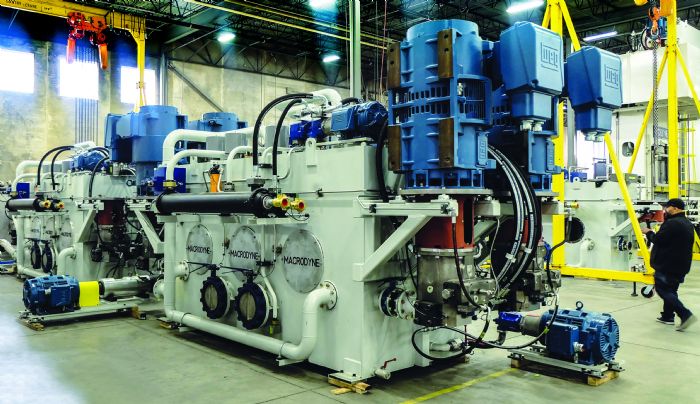 A hydraulic accumulator, a pressure vessel used to maintain pressure and recapture and store energy, enables a hydraulic system to cope with demand extremes with a less powerful pump. If a metal former’s operation requires a powerful energy jolt, but only at intervals, energy can accumulate while the press sits idle, such as during part removal or material reloading. Basically, the peak-horsepower requirement is averaged over an interval of time.
A hydraulic accumulator, a pressure vessel used to maintain pressure and recapture and store energy, enables a hydraulic system to cope with demand extremes with a less powerful pump. If a metal former’s operation requires a powerful energy jolt, but only at intervals, energy can accumulate while the press sits idle, such as during part removal or material reloading. Basically, the peak-horsepower requirement is averaged over an interval of time.
How it works: The pump reserves excess energy in a high-pressure nitrogen accumulator, built with a divider between nitrogen on one side and hydraulic oil on the other. As oil is pushed into the accumulator, the nitrogen compresses and creates stored energy in the system. Then, in response to a temporary demand surge, a valve opens and releases this energy as the compressed nitrogen forces the oil quickly into the system.
Instead of employing a 1000-hp hydraulic power unit for an operation needing an energy surge once every 30 sec., the press can use a 230-hp motor on the unit that cycles continuously, storing unused energy in the accumulator during the rest of that cycle. A press needing perhaps 1000 amps at peak times can cycle at 300 amps due to no huge peak at any given time. That constancy simplifies energy consumption management. The press operates at a reduced peak horsepower, and as a result, lowers its peak power demand significantly.
Regenerative Power
While accumulators help store and release energy to reduce peak demand, another key innovation—regenerative power—goes a step further by capturing and reusing energy that, otherwise, would be lost during operation.
Pressurized fluid returning to the tank and pushed through a valve wastes energy. However, forcing this fluid back through the pump empowers the motor to capture that energy so it can be regenerated back either into capacitors that store them in the system or into the power grid. The concept is similar to how braking stores energy into a capacitor, then reused as regenerative power.
Extreme-High-Pressure Piston Pumps
Extreme-high-pressure piston pumps are installed in larger press systems that run pressures greater than 5000 psi. The pumps can run as high as 10,000 psi while having the same type of onboard electronic control as the lower-pressure pumps. Previously, very high-pressure pumps were the fixed-displacement type that discharged only one rate of flow. Metal formers had to manage the extra flow with relief valves, or the extra energy went to waste.
Using this higher pressure allows stampers to use a small cylinder, and hence, a smaller press—rendering a higher-tonnage press in a smaller footprint.
Synchronizing Press Fleet
When metal formers operate multiple stamping presses running slow applications, they can program them to work as a fleet in a staggered pattern, rather than simultaneously, to eliminate huge power draws to the plant. Everything works in a coordinated way to suppress the plant energy draw.
Multifunctionality
A hydraulic press is a rare machine that can span several industrial applications: metal stamping, deep drawing, hot stamping, superplastic forming, forging and compression molding of plastic materials.
With properly designed tools, frames and guidance systems, a hydraulic press can perform compression molding as well as deep drawing, or stamping and hot stamping, just by changing the programming, for example. One customized hydraulic press can be built with multiple capabilities like a Swiss Army knife—instead of buying four different presses, a manufacturer can buy only one.
Again, many of these upgrades have been available for a while, but because costs have lowered significantly, they can be installed factory-standard. MF
View Glossary of Metalforming Terms
See also: Macrodyne Technologies, Inc.
Technologies: Stamping Presses
Comments
Must be logged in to post a comment. Sign in or Create an Account
There are no comments posted.Stamping Presses and Shut Height—What Every Tooling Engineer...
Peter Ulintz February 25, 2025







 Many advancements in hydraulic press technology have been driven by metal formers’ need to reduce energy—especially peak energy. As power becomes more expensive, energy consumption and savings have become more of a concern. Stampers look at their overall operating costs and seek energy savings to achieve that. Cutting hydraulic press energy usage to 10% realizes huge savings.
Many advancements in hydraulic press technology have been driven by metal formers’ need to reduce energy—especially peak energy. As power becomes more expensive, energy consumption and savings have become more of a concern. Stampers look at their overall operating costs and seek energy savings to achieve that. Cutting hydraulic press energy usage to 10% realizes huge savings.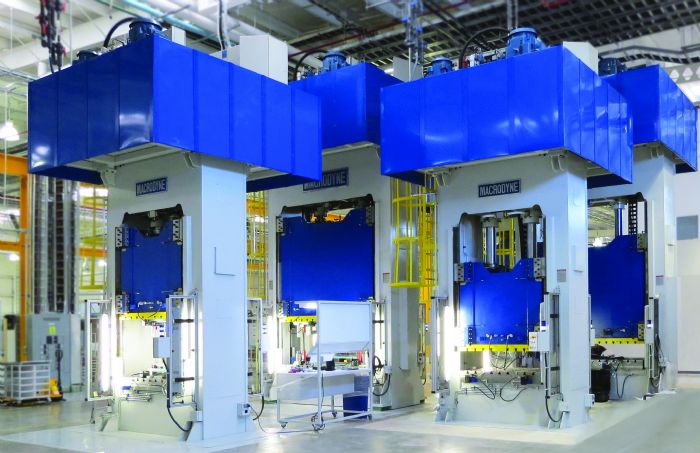 A pump controller with Ethernet communication quickly can display relevant information about the pump on a screen. The press’ control system receives data about exactly what the pump is doing and can send it new commands based on what the data indicates.
A pump controller with Ethernet communication quickly can display relevant information about the pump on a screen. The press’ control system receives data about exactly what the pump is doing and can send it new commands based on what the data indicates.